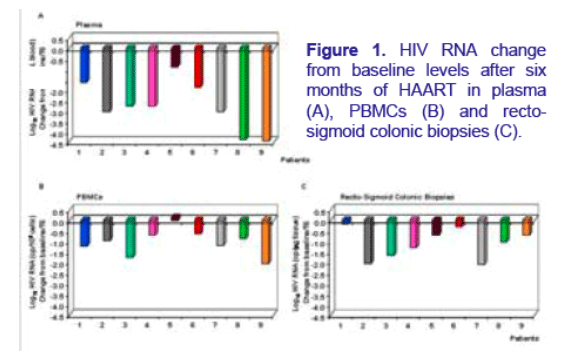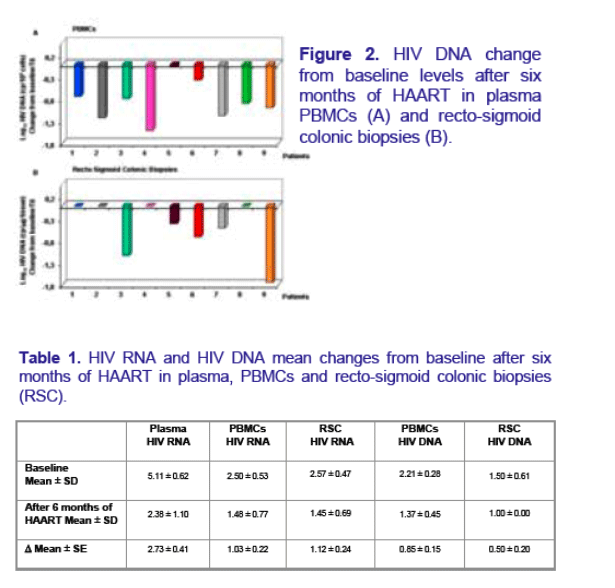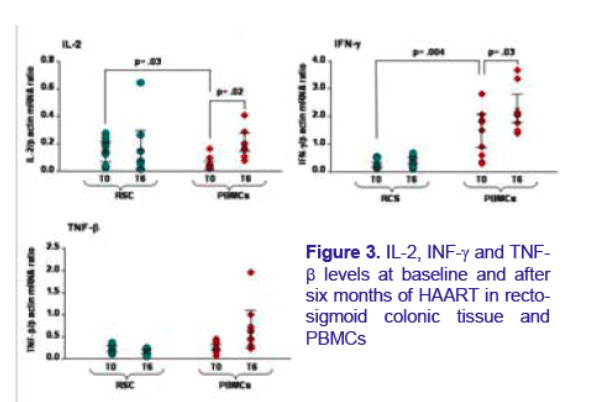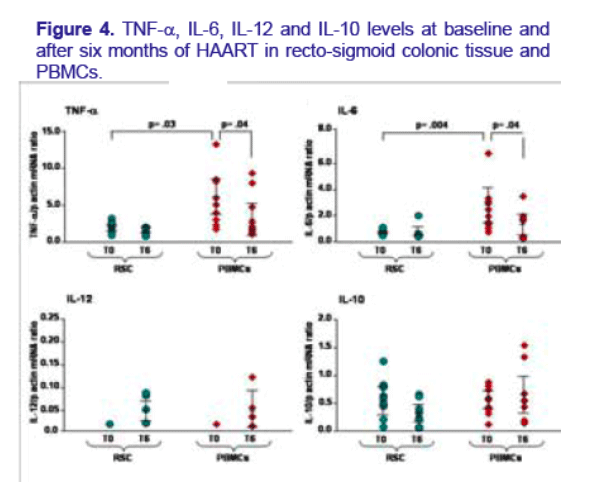 |
 |
 |
| |
Viro-Immunologic Abnormalities in Gut Associated Lymphoid Tissue
Caused by Acute HIV Infection are not Reverted by Early Initiation of HAART
|
| |
| |
Reported by Jules Levin
CROI Montreal Feb 8-12
Camilla Tincati1, Mara Biasin2, Alessandra Bandera3, Michela Violin4, Giulia Marchetti1,Nicola Squillace3, Alessandro Soria3,
Claudia Balotta4, Monica Airoldi3, Fabio Franzetti4, Mario Clerici2 and Andrea Gori 3*
1Department of Medicine, Clinic of Infectious Diseases and Tropical Medicine, San Paolo Hospital, University of Milan, Milan, Italy; 2Department of Preclinical Sciences, Chiar of Immunology, University of Milan, Milan, Italy; 3Division of Infectious Diseases San Gerardo Hospital, University Milano-Bicocca, Monza, Italy; 4Department of Clinical Sciences, Chair of Infectious Diseases, Luigi Sacco Hospital, University of Milan, Milan, Italy
"This study shows that the GI muscosa is a unique site of HIV infection which behaves differently compared to other reservoirs during PHI, as demonstrated by the lack of efficient clearing of intracellular HIV DNA levels, despite early introduction of antiretroviral therapy"
from Jules: there are doubts that HIV in the gut represents the initial and reversible assault by HIV. Semma Desai reports in her poster at CROI that HIV initiates early aging or senescence of T-cells (see her poster). A question is can immune senescence be reversed or can intervention prevent immune senescence.
CROI: Immune Senescence, Activation and Abnormal T cell Homeostasis Despite Effective HAART, A Hallmark of Early Aging in HIV Disease - (03/03/09)
ABSTRACT
Objective- During the acute phase of HIV infection, a massive CD4+ T cell depletion occurs in the gastrointestinal tract. The kinetics of CD4+ decline and HAART-mediated immunereconstitution were evaluated by comparing peripheral blood samples and GALT biopsies.
Patients and methods- Recto-sigmoid colonic biopsies (RSC) and blood samples of nine acutely HIV-infected patients were collected. CD4+ cells, HIV RNA, intracellular HIV DNA and mRNA cytokine expression were evaluated prior to and after six months of HAART.
Results- All nine patients presented a symptomatic retroviral infection. Whereas early HAART introduction was associated with a significant and comparable reduction of HIV in plasma, PBMCs and RSC, HIV DNA decreased in PBMCs but was only marginally reduced in RSC. Comparisons between the rate of reduction of HIV DNA in these two compartments, confirmed that HIV DNA clearance was significantly less efficient in RSC compared to PBMCs. Assessment of immunological profiles in PBMC and RSC showed that the Th1-like/Th2-like ratio (IL-2/IL-10) was sharply decreased in RSC while it increased in PBMCs throughout the study period. A persistent Th2-like profile was detected in RSC, whereas the efficient clearing of HIV DNA observed in PMBCs did correlate with the establishment of a more favorable Th1-like profile.
Conclusions- Early HAART introduction does not contain the establishment of HIV infection in GALT. A less efficient clearance of intracellular HIV DNA is associated with the persistence of immunological impairment in GALT as reflected by the skewed expression of cytokines in this reservoir.
Primary HIV infection (PHI) is associated with a preferential depletion of CD4+ T cells in the gastrointestinal (GI) tract. Although early introduction of highly active antiretroviral therapy (HAART) in PHI has been proven to be virologically and immunologically beneficial, clinical implications of early versus deferred therapy remain controversial. Indeed, the majority of patients treated during acute infection fail to achieve complete reconstitution of the CD4+ T cell subset in the GI mucosa, despite undetectable HIV viremia. Aim of our study was to comparatively assess the kinetics of viro- immunological parameters in peripheral blood, PBMCs and GI tract from acutely infected, HAART-treated HIV-positive patients.
METHODS
Nine patients with PHI were included. Acute HIV infection was defined by presence of signs and symptoms of acute retroviral syndrome, high risk exposure to HIV in the last 3 months, detectable plasma HIV RNA levels, and either a negative result of HIV ELISA or a positive result of ELISA with an indeterminate result (less than 3 bands) of HIV Western blot analysis. Peripheral blood samples and RSC biopsies were obtained before HAART initiation and following six months of therapy. PBMCs were obtained by gradient separation from EDTA-blood samples. RSC biopsies were snap- frozen and stored for biomolecular analysis. Flow-cytometry was performed on freshly isolated PBMCs. HIV RNA plasma copies were quantified by means of a nucleic acid signal-amplification assay (lower detection limit: 50 cp/mL).
Cell and tissue associated viral DNA and RNA were extracted using the High Pure PCR Template Preparation Kitfs Roche and QIAamp Viral RNA Kit and quantifed by RT competitive PCR. Total RNA for cytokine production (IL-2, INF-γ_, TNF-α, TNF-α, IL-6, IL-12, IL-10) was extracted from PBMCs and biopsy specimens by acid guanidium thiocyanate-phenolchloroform extraction method; cytokine RNA was retro-transcribed into cDNA which was then quantified by PCR analysis. Paired T Test and Wilcoxon Signed-Rank Test were performed for normally and not normally distributed variables, respectively. All p-values produced were regarded as descriptive and no inferences were made.
RESULTS
No differences were observed among patients regarding demographic, clinical and HIV-related parameters. Mean CD4+ T cell counts at baseline were 482 ± 109 cells/mL and increased dramatically after six months of HAART (mean: 989 ± 385 cells/mL; p= .002). HAART resulted a marked decrease of HIV RNA plasma levels in all patients (mean decrease 2.73 ± 0.41 log10 cp/mL; p= .0001; Fig. 1A, Tab. 1), although suppression of HIV RNA levels was not achieved in all individuals (i.e. patients 1, 5 and 6). Overall, early HAART introduction accounted for HIV RNA decrease in PBMCs (mean decrease: 1.03 ± 0.22 log10 cp/106 cells, p= .0007; Fig 1B, Tab. 1) and RSC biopsies (mean decrease: 1.12 ± 0.24 log10 cp/μg, p= .0007; Fig 1C, Tab. 1). Patients who did not reach undetectable HIV plasma levels at month 6 of follow-up showed a less pronounced decrease of viremia in reservoirs.

Six months of HAART resulted in a sustained decrease of intracellular DNA in PBMCs (mean decrease of 0.85 ± 0.15 log10 cp/106 cells, p= .0002, Tab. 1), with patients 1, 5 and 6 presenting the smallest decrease (Fig. 2A).
In contrast to these results, intracellular HIV DNA in RSC lymphoid tissues was only partially reduced (mean HIV DNA levels: 1 log10 cp/μg; mean decrease 0.50 ± 0.20 log10 cp/μg, p= .04; Fig. 2B, Tab. 1). Moreover, when comparing the rate of reduction of HIV DNA in these two reservoirs, a trend to a less efficient clearance of HIV intracellular DNA was observed in RSC (p= .07)

Higher IL-2 and lower INF-γ_ levels were detected in RSC compared to PBMCs at baseline. While clearance of HIV increased IL-2 and INF-γγ in PBMCs (Fig. 3), the reduction of HIV levels did not correlate with changes of these two cytokines in RSC. TNF-α expression showed an increase in PBMCs alone (Fig. 3). TNF-α and IL-6 were higher in PBMCs and HAART accounted for their decrease (Fig. 4). No differences were observed in IL-12 and IL-10 between compartments (Fig. 4). Overall, cytokine expression in the two compartments underlines a dichotomous trend, concordant with the virological results: on one hand, the slow decrease of HIV DNA in RSC associates with a Th2-like profile; on the other, efficient clearing of HIV DNA in PBMCs correlates with the establishment of a more favorable Th1-like profile.


AUTHOR CONCLUSION
This study shows that the GI muscosa is a unique site of HIV infection which behaves differently compared to other reservoirs during PHI, as demonstrated by the lack of efficient clearing of intracellular HIV DNA levels, despite early introduction of antiretroviral therapy. A lesser control over infection may account for the poor immunological profile in the GI tract compared to peripheral reservoirs. Prevention of mucosal assault by means of alternative therapeutic strategies may represent the turning point in the treatment of acute HIV infection and optimize the use of HAART in this key phase of HIV disease.
|
| |
|
 |
 |
|
|